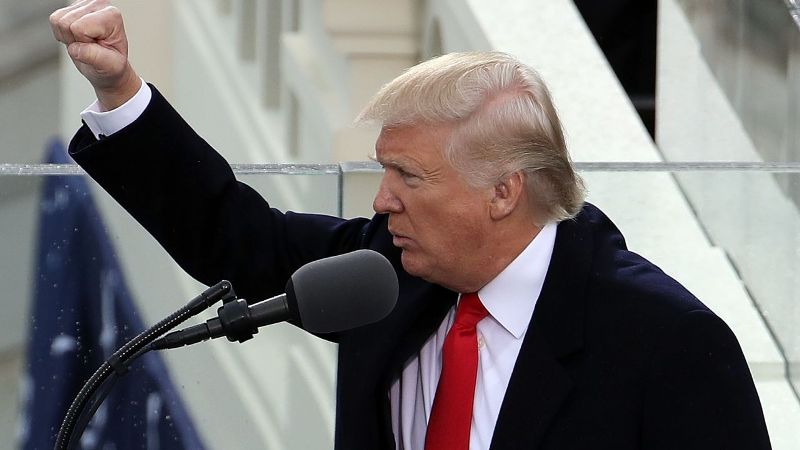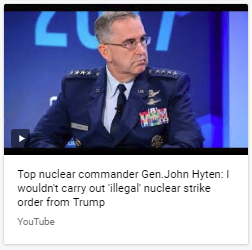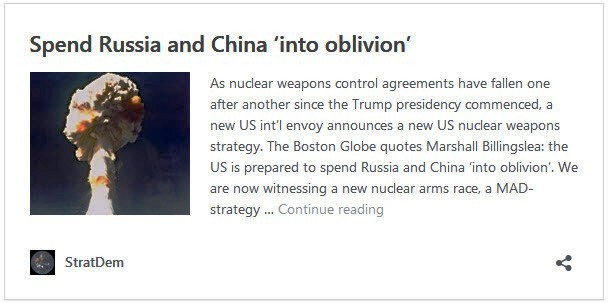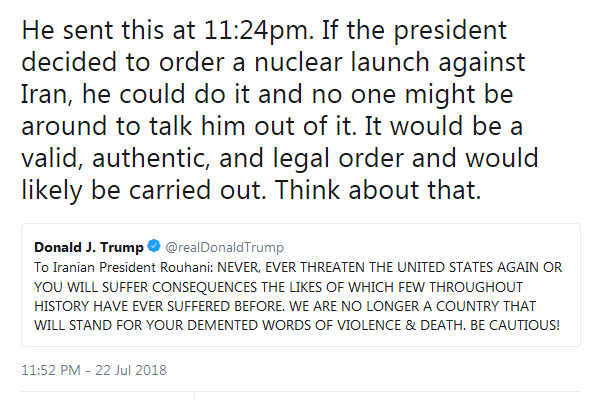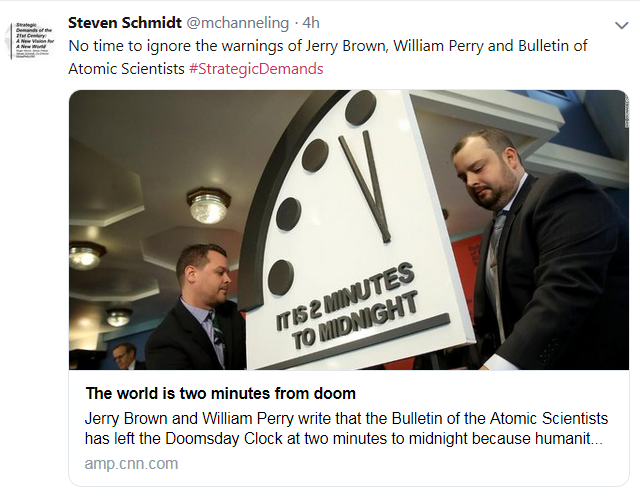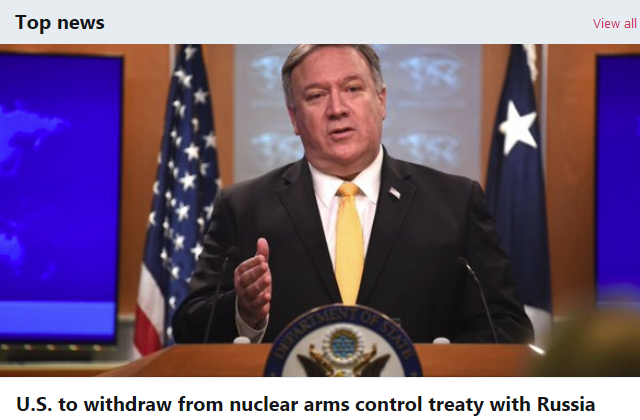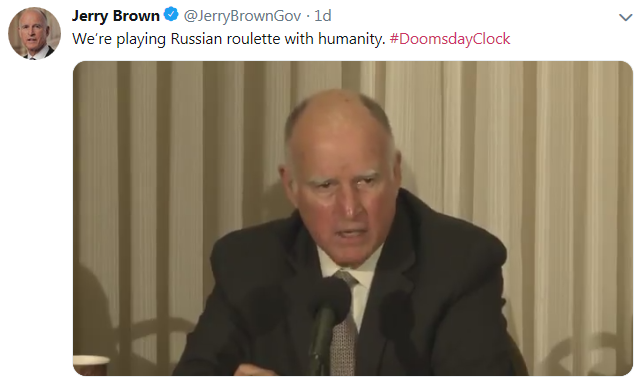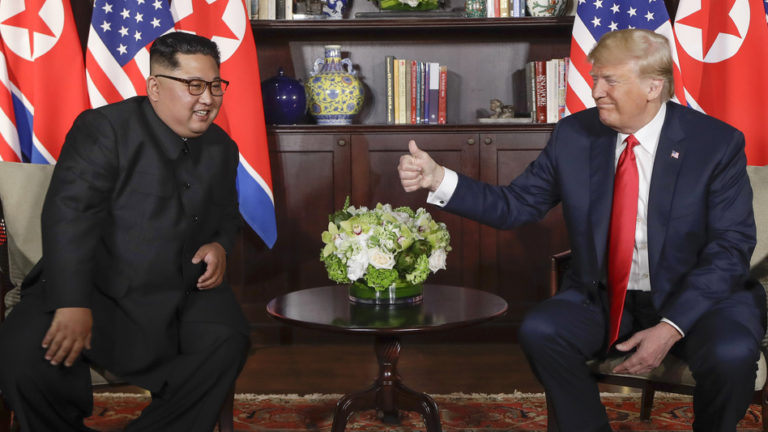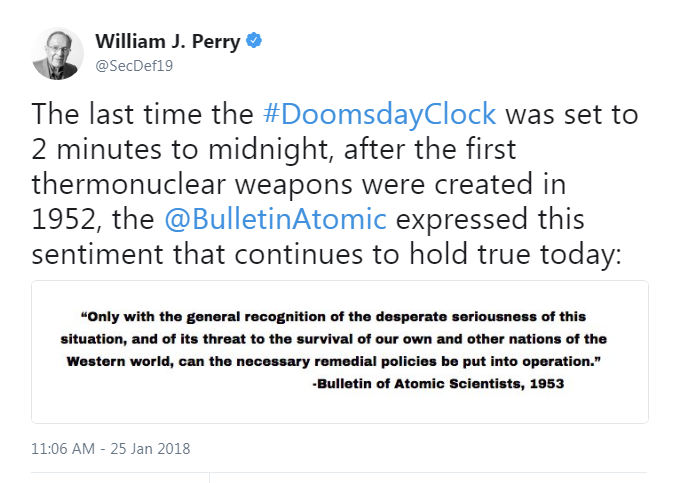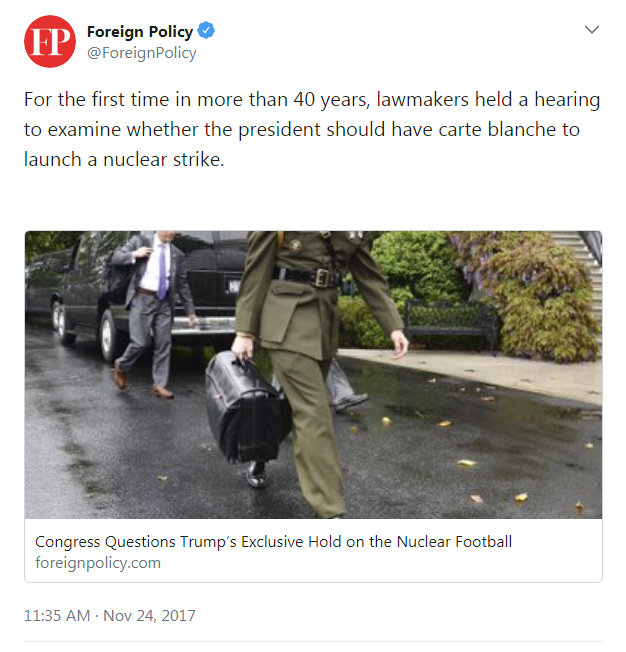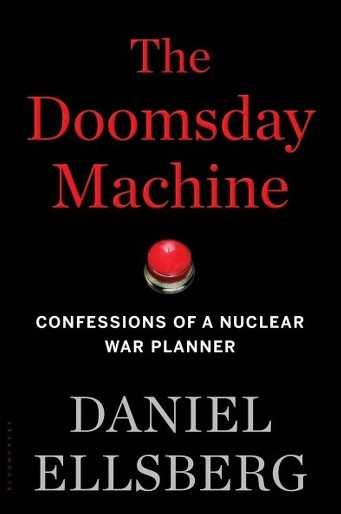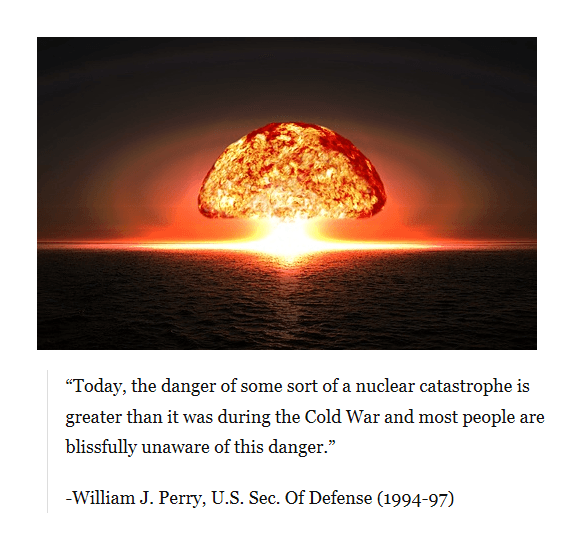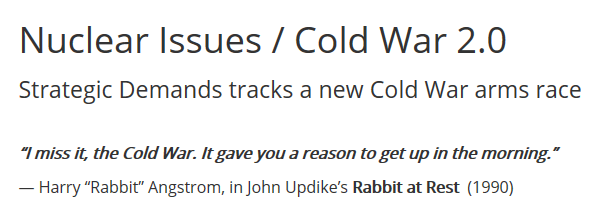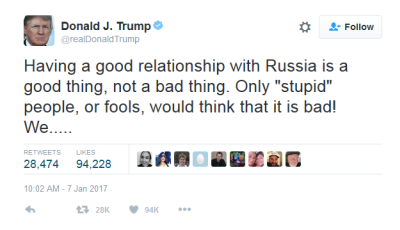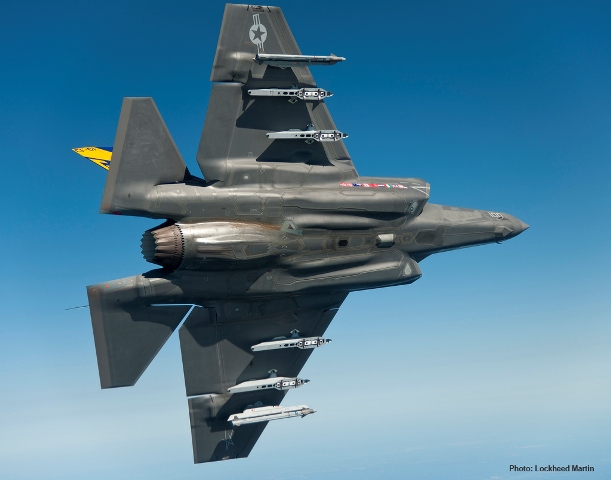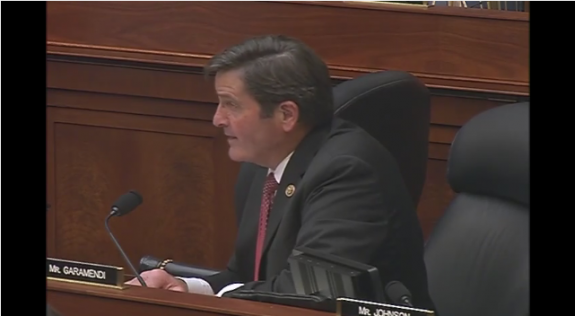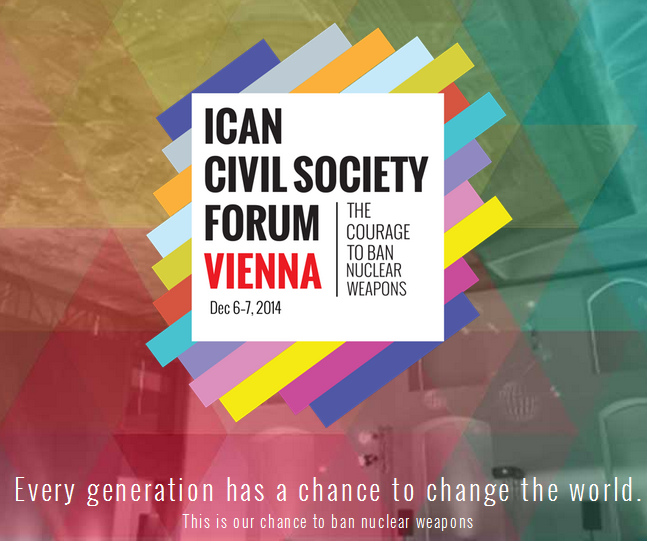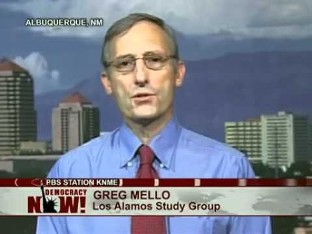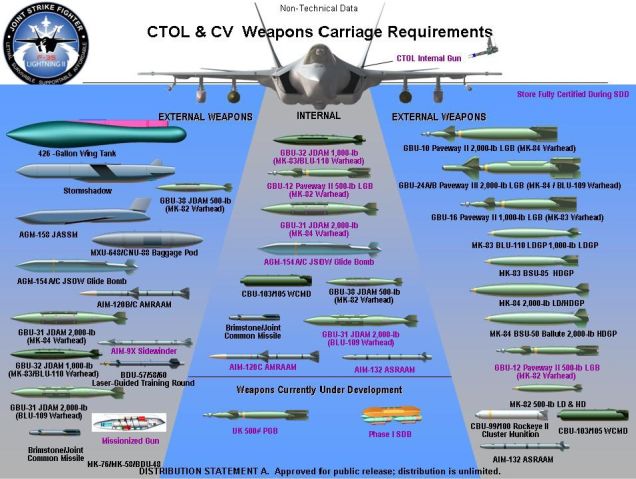Nuclear Weapons
····························································
The Button, Bolton & Trump
- June 2020
A John Bolton interview. Another warning about command and control of nuclear weapons presents itself. A series of threats, abandoned arms agreements, collapsed diplomacy, escalations and provocations emanate daily in the news. How often, over the years, do we have to be warned of ‘erratic’ decisions delivering catastrophic consequences
As Wolf Blitzer of CNN airs a live interview with John Bolton, former US National Security Advisor, your Strategic Demands editor takes notes. Most striking is Bolton's repeated warnings of erratic behavior and decisions of the US president. Bolton repeats himself in explaining there is no coherent policy, there is an erratic pattern in "The Room" at the White House.
This bring us to an accelerated nuclear weapons race that the US, under President Trump, initiated. Bolton's insider story of erratic policy of the president resonates and reverberates. In fact, the consequences of the Trump administration's nuclear weapons escalation have set a legacy in motion of new nuclear risks on land, sea, in air and in space.
As the daily news cycle and latest chaotic headlines distract and draw attention, a disaster-in-the-making develops.
- ································································································································
- ············································································
2020
A MAD STRATEGY
2019
Pope Francis: With deep conviction I wish once more to declare that the use of atomic energy for purposes of war is today, more than ever, a crime not only against the dignity of human beings but against any possible future for our common home. The use of atomic energy for purposes of war is immoral, just as the possessing of nuclear weapons is immoral, as I already said two years ago. We will be judged on this. Future generations will rise to condemn our failure if we spoke of peace but did not act to bring it about among the peoples of the earth. How can we speak of peace even as we build terrifying new weapons of war?”
Pope urges abolition of nuclear weapons during Japan visit
24 November 2019
Pope Francis has made an impassioned appeal for the abolition of nuclear weapons during a visit to Nagasaki, one of the two Japanese cities targeted by atomic bombs during World War Two.
He decried the "unspeakable horror" of nuclear weapons and insisted they were "not the answer" for global peace.
At least 74,000 were killed in Nagasaki by the attack by US forces in 1945...
In a sombre ceremony, the Pope unequivocally condemned the use of nuclear weapons.
"This place makes us deeply aware of the pain and horror that we human beings are capable of inflicting upon one another"...
In Hiroshima today, Pope Francis declared the use and possession of atomic weapons "immoral."
························································
Via GreenPolicy360's associate, Strategic Demands
Another Nuclear Weapons Control Treaty 'Bites the Dust'
• https://www.strategicdemands.com/another-nuclear-weapons-treaty-bites-the-dust/
Return to Doomsday
• https://www.nytimes.com/2019/08/01/world/asia/inf-missile-treaty.html
“The United States and Russia are now in a state of strategic instability,” Ernest J. Moniz, the former energy secretary, and Sam Nunn, the former Georgia senator who helped draft the legislation that funded the drastic reduction in former Soviet nuclear forces, write in a coming article in Foreign Affairs ominously titled “The Return to Doomsday.” “Not since the 1962 Cuban missile crisis has the risk of a U.S.-Russian confrontation involving the use of nuclear weapons been as high as it is today. Yet unlike during the Cold War, both sides seem willfully blind to the peril.”
························································
Carnegie Nuclear Policy Conference
Regional Nuclear Conflict will deliver, science says, Global Nuclear Catastrophe
"One Mistake Away"
Global security and protection/preservation of the atmosphere in immintent... Watch this scientist talk of the clear and present dangers of nuclear war. We are "one mistake away" from nuclear war initiated by any of the nuclear weapons countries (the United States, Russian Federation, China, India, Pakistan, Israel, France, the United Kingdom, North Korea) leading to regional impacts spreading to global winter and collapse of civilization. The scientists explain what will happen in the high atmosphere, in what we at GreenPolicy360 refer to as the "thin blue layer".
February 2019
- Intermediate Nuclear Forces Treaty Threatened
- The #INFTreaty — the proud achievement of Reagan and Gorbachev — is now destined for the dumpster because of the ignorance of @realDonaldTrump. Such mindless escalation of nuclear danger is insane. 🚨 It’s 2 minutes to midnight.
- More from the Bulletin of Atomic Scientists - https://thebulletin.org/collections/the-inf-and-the-future-of-arms-control/
January 2019
January 24, 2019
Governor Brown, William Perry Warn of Nuclear Weapons Peril: Two Minutes to Midnight
····················································································································
Preparing for Helsinki: Question to Ask, Open Letter for Putin and Trump
····················································································································
- ···················································································································
North Korea and US Meet in Singapore
June 12, 2018 / After the Singapore summit, the commentators, op-ed writers, columnists, analysts, foreign policy experts and seemingly everyone within reach of a keyboard or smartphone all have an opinion. Who are we not to join in with StratDem’s opinion? Consider the alternative to negotiating, “politics by other means”, war and potential catastrophic use of nuclear weapons...
·············································································
Proliferation and Counter-proliferation
WASHINGTON / May 2018 — For the White House, these have been dramatic days for nuclear disarmament: First President Trump exited the Iran deal, demanding that Tehran sign a new agreement that forever cuts off its path to making a bomb, then the administration announced a first-ever meeting with the leader of North Korea about ridding his nation of nuclear weapons.
But for the American arsenal, the initiatives are all going in the opposite direction, with a series of little-noticed announcements to spend billions of dollars building the factories needed to rejuvenate and expand America’s nuclear capacity.
The contrast has been striking...
The US President, Commander-in-Chief
- Catastrophic Danger of Nuclear Weapons Use
GreenPolicy Siterunner / The imminent US Nuclear Posture Review brings additional danger in its proposal for new 'usable' tactical nuclear systems and launch capabilities. The so-called current US Nuclear Triad is in fact much than a three-pronged delivery system and new so-called limited yield, 'dial up' nuclear weapons and expanded delivery systems is a recipe for disaster. The US Congress and public need to look at these new systems more closely before they are funded/developed and/or deployed, as in the case of the F-35 nuclear cruise missiles and 'smart' guided nuclear warheads.
Nextgen tactical (as opposed to strategic) nuclear weapons, if used, will bring catastrophic consequences...
The notion that the current president would have usable nukes under his singular authority to launch should be a cause for alarm in itself.
Strategic Demands has proposed legislation to address this -- as has the US Congress, having held its first hearing in over 40 yrs on nuclear command and control.
The proliferation of nukes is the issue of issues...
"Singular Authority" to Launch Nuclear Weapons
StratDem: Need to Change Nuclear First-Strike Authority
No One Should Have Singular Nuclear-Launch Authority
- To prevent nuclear first use -- http://strategicdemands.com/prevent-nuclear-first-use/
- A "Nuclear Meme" -- http://strategicdemands.com/a-nuclear-meme/
- Oversight of the US Nuclear Arsenal -- http://strategicdemands.com/oversight-us-nuclear-arsenal/
More @Strategic Demands / #StratDem -- https://strategicdemands.com
November 14, 2017
One year after the election of a new US president, today, the US Congress held a committee hearing to consider presidential nuclear first use/first strike authority.
The last time this nuclear command and control issue was considered by Congress in an open hearing was over forty years ago. It is a profound issue and a rising crisis has the US president threatening first use, preemptive strikes against North Korea.
Nuclear retaliation and catastrophe looms as 2018 approaches.
GreenPolicy and our associate organization Strategic Demands continue to track the crisis and advocate for immediate diplomacy and new controls over first use of nuclear weapons.
In an article published in Foreign Policy in 1984, Jeremy Stone (https://en.wikipedia.org/wiki/Jeremy_Stone) concluded that "presidential first use [of nuclear weapons] is unlawful."
Concern than over nuclear use and resulting cataclysmic consequences has reached mainstream media around the world.
Threats to obliterate a country (North Korea) made on social media (Twitter) by one man who can order nuclear strikes with sole authority is unacceptable.
As Green politics has since its inception argued again nuclear weapon proliferation and threats of nuclear use, we continue to point out the existential, human and environmental risks.
It is time for new international controls over nuclear weapons systems, command and control.
Dan Ellsberg, nuclear war planner
- Ellsberg looks back and looks forward in his new book
- Command and control of nuclear weapons
- The Doomsday Machine
Questions of first use/preemptive use/preventive use/misuse and retaliatory use
- Regional and Global disaster
Legislation to ban Trump from first use of nuclear weapons
Nuclear Videos
The Day After
- https://www.youtube.com/watch?v=yif-5cKg1Yo (Full Movie)
The Day After is a 1983 American television movie that aired on November 20, 1983, on the ABC television network. It was seen by more than 100 million people during its initial broadcast. It is currently the highest-rated television movie in history.
The movie postulates a fictional war between NATO forces and the Warsaw Pact that rapidly escalates into a full-scale nuclear exchange between the United States and the Soviet Union. However, the action itself focuses on the residents of Lawrence, Kansas, and Kansas City, Missouri, as well as several family farms situated next to nuclear missile silos.
○ ○ ○ ○ ○ ○ ○ ○ ○ ○ ○ ○ ○ ○ ○ ○ ○ ○ ○ ○ ○ ○ ○ ○
Cold War 2.0: Ramping Up toward Hot War
StratDem: Nuclear Weapons Proliferation or Nonproliferation
- ○ ○ ○ ○ ○ ○ ○ ○ ○ ○ ○ ○ ○ ○ ○ ○ ○ ○ ○ ○ ○ ○ ○ ○
UN Treaty Prohibiting Nuclear Weapons / July 5, 2017
United Nations conference to negotiate a legally binding instrument to prohibit nuclear weapons, leading towards their total elimination
New York, 27-31 March and 15 June-7 July 2017
A legally binding instrument to prohibit nuclear weapons, leading towards their total elimination
Treaty on the Prohibition of Nuclear Weapons
○ ○ ○ ○ ○ ○ ○ ○ ○ ○ ○ ○ ○ ○ ○ ○ ○ ○ ○ ○ ○ ○ ○ ○
There's No Winning a Global War / June 28, 2017
- https://www.greenpolicy360.net/w/File:Surviving_Victory_Conf_contributors.jpg
- https://www.greenpolicy360.net/w/File:Strategic_Demands_of_the_21st_Century_A_New_Vision_for_a_New_World.jpg
- https://www.greenpolicy360.net/w/File:Surviving-Victory-conference-Washington-DC-2006.pdf
Trump Appointment to Head the Energy Dept Is a Man Who Campaigned to Abolish the US Energy Dept
- The US Energy Department overseeing nuclear weapons development, 'stewardship' of the existing stockpile, pits/triggers, testing...
- A trillion dollar "modernization" of the nuclear weapons complex is a core component of a full-spectrum next generation of nuclear weapons
- New 'usable' US nuclear weapons systems; digital nuclear command & control; in response China, Russia, other nuclear nations in 'reactionary' mode
Nuclear Weapons, Negotiations, or New Arms Race
Donald Trump, inaugurated on January 20th as the 45th U.S. president, raised the prospect of the first big nuclear arms control agreement with Moscow since the Strategic Arms Reduction Treaty signed by President Barack Obama in 2010.
"They have sanctions on Russia — let’s see if we can make some good deals with Russia," the Republican president-elect was quoted as saying by The Times.
"For one thing, I think nuclear weapons should be way down and reduced very substantially, that’s part of it. But Russia’s hurting very badly right now because of sanctions, but I think something can happen that a lot of people are gonna benefit."
Mixed Messages
- Nuclear Weapons: Proliferation vs Nonproliferation
····················································································
The Most Destabilizing of Next Generation Nuclear Weapons
····················································································
- Closer to Midnight
Bulletin of Atomic Scientists
Air-Launched Cruise Missiles (ALCMs) -- https://en.wikipedia.org/wiki/Air-launched_cruise_missile
- Nuclear-tipped -- Nuclear-armed ALCMs and NextGen 'Fifth-generation', 'Block 4 development-phase'
◊
F-35 and NextGen Nuclear Weapon and Missile Delivery
- The F-35 is the first software upgradeable tactical jet ever built and the evolution of its software will be determined by operational experiences
- On 2 August 2016, the U.S. Air Force declared its first squadron of F-35A fighters combat-ready...
- Design goals call for the F-35 to be the premier strike aircraft through 2040...
- Upgrades: 'Block 4' F-35s will receive four potent weapons, the SDB glide, small diameter bombs, Naval Joint Strike missiles, Raytheon's Small Advanced Capability missiles, and a Miniature Self-Defense Munition (MSDM)
Family of Weapons
- Lockheed Martin Missiles and Fire Control is studying a new small size cruise missile design, optimised for internal carriage, under its LCMCM programme. This is part of a wider effort by the company to produce a family of reduced size future weapons that includes the Surveilling Miniature Attack Cruise Missile (SMACM). Like the SMACM, the LCMCM is intended to equip the internal weapons bays of the F/A-22 Raptor and F-35 Joint Strike Fighter. The new missile is planned to be in the 1,000 lb weight class and to offer a range of 1,000 miles. Lockheed Martin is conducting its LCMCM studies with the US Air Force Research Laboratory, at Eglin AFB. During 2002 Lockheed Martin built and flew a cruise missile technology demonstrator known as Owl.
AGM-86B
- The nuclear armed AGM-86B uses a terrain contour-matching guidance system (TERCOM) to fly to its assigned target
- To replace ALCMs with NextGen missiles, the USAF awarded contracts for a new Long-Range Stand-Off (LRSO) weapon in 2015
- The LRSO program is to develop a weapon that can penetrate and survive integrated air defense systems and prosecute strategic targets. Both conventional and nuclear versions of the weapon are required to reach initial operational capability (IOC) before the retirement of their respective ALCM versions, around 2030
F-35 Could Carry B61 Nuclear Warhead Sooner Than Planned
Air Force Brig. Gen. Scott Pleus ... Arming the F-35 with the nuclear bomb will require some extra training for pilots, but nothing out of the ordinary from their usual regimen ...
It’s unclear whether or how the program might be impacted by President-elect Donald Trump’s calls for the U.S. to “expand its nuclear capability.” Trump has previously said the U.S. would “outmatch” rivals in a nuclear arms race ...
(Via Second Line of Defense)
Integrating Nuclear Weapons Into the Offensive-Defensive Enterprise
If one is dealing with combat with a small nuclear power (like North Korea), it is not enough to shape a completely conventional warfare strategy.
It is incumbent on the force planner to integrate nuclear strike into the planning and in providing a means to persuade the adversary that it is simply not credible to use his nuclear weapons as a first strike weapon or a weapon that can not be neutralized in effective ways by attacks on his C2 (Command and Control), delivery assets or storage facilities.
It is about designing from the ground up a credible offensive-defensive capability to effectively defeat a small nuclear power.
It is not about wishful thinking or remaining in the rules of engagement shaped in the first nuclear age; it is entering into an age where the use of nuclear weapons can be imagined once again.
The US Navy refers to the shaping of such distributed capabilities in terms of either “distributed lethality” or the “kill web.” The notion is that strike is distributed throughout a web or honeycomb and that strike can be distributed through a self learning web operating in a high threat environment.
It is crucial as well to design weapons which can be integrated into an offensive-defensive or distributed force where very limited use would be envisaged and only in clear need of doing so. This is why what nuclear warheads, which have historically been called tactical nuclear weapons, combined with advanced delivery technologies becomes a key focus of attention in one’s warfighting force.
It is deterrence based on actual warfighting capabilities; not the words of a diplomatic kabuki dance.(Ed: StratDem disagrees with their position about use of nuclear weapons instead of a 'diplomatic kabuki dance' with its bizarre characterization of nuclear weapons use)
The F-35 when married to a small yield nuclear weapon clearly can be a key part of such an evolution.
The ability of the F-35 to command situational awareness of 360 degree space and to be able to determine with high precision a target set, and to operate passively while doing so, provides an ideal platform for the delivery of a small yield weapon against appropriate targets as part of an overall campaign against an aggressive small nuclear power.
The redesign of weapons associated with the evolution of the aircraft, and perhaps other delivery vehicles such as hypersonic weapons needs to be part of the effort to deal with second nuclear age powers.
It is about clearly both the evolution of weapons technology as well as delivery technology.
And with the software upgradeable approach of the F-35, their can be an open ended evolution of the aircraft highly interactive with the evolution of weapons delivery and performance as well.
The Current F-35 and Tactical Nuclear Weapons Approach
The F-35 is a block upgradeable aircraft; in the fourth block in the evolution of the aircraft, currently under design and testing, nuclear weapons delivery will be integrated onto the aircraft.
This design capability will be operational by 2018...
◊
2017, an Inauguration and an Impulsive Commander-in-Chief
Via Strategic Demands / GreenPolicy360's associate -- www.StrategicDemands.com
As the US Preps for a New President
Now is the time to set in place additional protection against first-use
Poll: Nearly half of voters think Trump will detonate a nuke
Donald Trump: “Why are we making them?” … ‘If we have them, why can’t we use them?’
- Re: the President’s Last Days as Commander-in-Chief
A New Era, A Return to the Cold War
New, more lethal, 'smart', 'usable' tactical and strategic nuclear weapons
re: Cold War 2.0 / Cold War 2.0 Accelerates
Calculus of War; Cold War 2.0; Nuclear Proliferation; Hypersonic Arms Race
October 30, 2016 / From Strategic Demands
The rapid escalation of nuclear weapons systems by the US, Russia, China and other nuclear weapon capable countries has another news flash — the announcement by the Russian Federation of a change in schedule for a next generation of nuclear MIRVs. The new production dates have been moved up with the next iteration of the multiple nuclear warhead Sarmat RS-28.
The RS-28 has been labeled Satan-2 by adversaries. Satan-1 missiles, though fully capable of producing a global apocalypse, will be ‘retired’ to be replaced by the more assuredly apocalyptic Satan-2 . The public position of the Russian government is the newest massive offensive and defensive capabilities are necessary to counter a trillion dollar plus nuclear weapons “modernization” by the US and allies.
Cold War 2.0 is gathering momentum.
···························
'Satan' Sarmat
http://strategicdemands.com/satan-sarmat/
Read More:
US “Prompt Global Strike” initiative as reported by Sputnik
Russian Hypersonic (Tsirkon – Zirkon) Missile Project
First Hypersonics before 2020
Next-Generation Hypersonic Missiles
New US Nuclear-capable Cruise Missiles
- Hypersonic – Thermonuclear
- Long-Range Standoff (LRSO) weapons to replace Air Launched Cruise Missile (ALCM)
China-Russia Accelerate Hypersonic in response to US THAAD deployment
US STRATCOM Confirms Chinese Hypersonic Tests
-=-=-=-=-=-=-=-=-=-=-=-=-=-=-=-=-=-=-=-=-=-=-=-=-=-=-
Looking out at the nuclear weapons horizon, the nations of the world attempt a last effort to block and outlaw the coming array of nuclear weapons dangers ...
At the United Nations - To Ban or Not to Ban Nuclear Weapons
October 27, 2016
The United Nations today adopted a landmark resolution to launch negotiations in 2017 on a treaty outlawing nuclear weapons. This historic decision heralds an end to two decades of paralysis in multilateral nuclear disarmament efforts.
At a meeting of the First Committee of the UN General Assembly, which deals with disarmament and international security matters, 123 nations voted in favour of the resolution, with 38 against and 16 abstaining.
The resolution will set up a UN conference beginning in March next year, open to all member states, to negotiate a “legally binding instrument to prohibit nuclear weapons, leading towards their total elimination”. The negotiations will continue in June and July.
Ⅰ Ⅱ Ⅲ Ⅳ Ⅴ Ⅵ Ⅶ Ⅷ Ⅸ Ⅹ Ⅰ Ⅱ Ⅲ Ⅳ Ⅴ Ⅵ Ⅶ Ⅷ Ⅸ Ⅹ Ⅰ Ⅱ Ⅲ Ⅳ Ⅴ Ⅵ Ⅶ Ⅷ Ⅸ Ⅹ
- Visit GreenPolicy360's Associated Site, Strategic Demands
Ⅰ Ⅱ Ⅲ Ⅳ Ⅴ Ⅵ Ⅶ Ⅷ Ⅸ Ⅹ Ⅰ Ⅱ Ⅲ Ⅳ Ⅴ Ⅵ Ⅶ Ⅷ Ⅸ Ⅹ Ⅰ Ⅱ Ⅲ Ⅳ Ⅴ Ⅵ Ⅶ Ⅷ Ⅸ Ⅹ
- Atomic Clock Ticks Closer to Midnight
Read @ Strategic Demands: Nuclear Modernization, Proliferation, Escalating Risks
StratDem: "A New Nuclear Arms Race"
Noam Chomsky Speaks of a Doomsday Clock
-=-=-=-=-=-=-=-=-=-=-=-=-=-=-=-=-=-=-=-=-=-=-=-=-=-
2016 - 2015
As Stephen Hawking points to "runaway climate change", he also points at the other existential threat he sees -- nuclear weapons. We at GreenPolicy360 and our associate Strategic Demands continue to point out escalating threats on both fronts, even as the political establishment rushes forward to modernize a new generation of nuclear, 'smart' weapons and the fossil fuel industry fights to continue business-as-usual with unmatched money and political influence.
A Stark Nuclear Warning by William J. Perry
- Book Review by Jerry Brown
-=-=-=-=-=-=-=-=-=-=-=-=-=-=-=-=-=-=-=-=-=-=-=-=-=-=-
"Nuclear weapons remain one of the greatest threats"
US Administration and Congress Press Forward with Trillion Dollar+ Nuclear Modernization
- “We are well into a new nuclear arms race”
Congressman from California doesn't mince words, although few listen and fewer care
- The Nuclear Debate, as a "New Nuclear Arms Race" launches, is next to non-existant in the American media
Rep. John Garamendi was quoted saying during the Armed Services Committee hearing:
“You will come to realize that over the next 20 to 25 years, we'll be spending well over a trillion dollars on nuclear weapons systems. While we're doing it, so are Russia and China. It's an arms race, much like we saw in the ‘60s and ‘70s. And this one is particularly troublesome, because the weapons are far more sophisticated, the bombs are far more precise, and the delivery systems are too. Just think about the implications.” http://bit.ly/1OLTo4i
APRIL 29, 2015 / WASHINGTON, DC – Yesterday evening, during the House Armed Services Committee’s consideration of the FY2016 National Defense Authorization Act, H.R. 1735, Committee Member Congressman John Garamendi (D-Fairfield, CA) introduced and spoke in favor of a series of amendments that seek to better inform Congress about the costs and risks of America’s participation in a new nuclear arms race.
https://www.youtube.com/watch?v=3P1kO5-0Ax8&index=2&list=PLmEjJkmDUClc2wdFUYcdBDMk7naBxggMN ...a far more dangerous nuclear arms race.... modernizing... warheads, life extension... new delivery systems...
https://www.youtube.com/watch?v=-543a_RXoTc&feature=youtu.be&list=PLmEjJkmDUClc2wdFUYcdBDMk7naBxggMN NNSA modernization programs... the warheads and the platforms on which they will be deployed...
https://www.youtube.com/watch?v=Z3Fw7yrna0E&index=4&list=PLmEjJkmDUClc2wdFUYcdBDMk7naBxggMN plutonium pits, new pits, 50 to 80 a year, new facilities, why? Should the project be abandoned? let's not proceed with ignorance... Why do we fear information? We will be spending over the next 20 years a trillion dollars.... ignorance is not good...
Approving without needed information... the life extension program of hundreds, thousands of nuclear bombs...
..... new nuclear bombs and delivery systems
.....new subs
.....new fighters
.....new cruise missiles
.....new ICBMs
.....a new nuclear arms race...
.....a twenty-five year program...
.....a new nuclear 'umbrella'... Europe...
.....we really are into the first-quarter of a new nuclear arms race...
.....you will come to realize we will be spending over a trillion dollars, so will Russia and China..... the old rules don't apply
.....think about what the implications are, the implications are dire...
.....so pause for a moment
US Congress: Nuclear Weapons Funding Discussion/Debate
-=-=-=-=-=-=-=-=-=-=-=-=-=-=-=-=-=-=-=-=-=-=-=-=-=-=-=-=-=-=-=-
'QuickStudy' of the Nuclear Weapons Complex - Circa 2016
Contested Ground in the Absence of Nuclear Testing
Subscription - http://www.exchangemonitor.com/publication/nsd/contested-ground-absence-nuclear-testing/
By Roger Snodgrass
Dimitri Kusnezov, chief scientist of the National Nuclear Security Administration, fully subscribes to his agency’s commitment “to maintain a safe, secure and effective nuclear deterrent without nuclear testing,” but he also describes a more nuanced view of the contingent future of nuclear testing in a world that is always changing. “What does it take to ensure that we are actually stressing the system, that it’s not just a scientific or virtual side of the exercise? That if we have to deliver something we can?” he asked during a telephone interview this week. If necessary, he wonders, can the United States build the right weapon in a reasonable time frame to meet its national security needs?
“At the moment, we don’t see testing as an important part of that,” he said. “But we look at that carefully and that’s a real-time assessment that we are running continuously.” He worries that in the years to come, that Department of Energy nuclear laboratory directors who have not been involved in nuclear testing would not deeply understand how the guarantees for integrated total system performance must work in the domain of nuclear weapons. “It’s not visible to most people what we have to do to replace what we could do with the testing,” he added.
After decades of above-ground and underground test blasts, the question of U.S. nuclear testing was settled to some degree with a moratorium in 1992, during President George H. W. Bush’s last year in office. That answer was strengthened when President Bill Clinton first signed the Comprehensive Nuclear Test Ban Treaty in 1996, but then the door was left ajar again when the Senate voted 48-51 against ratifying the pact in 1999. And, although the moratorium is firmly established in current practice, a new president could cancel it with a signature...
At a recent meeting of a local arms control group in Los Alamos, N.M., John Hopkins, a former J-Division (weapons testing) director at the Los Alamos National Laboratory, addressed the subject of “Nuclear Testing: What is Needed and Why.” The talk expanded on a theme he had previously prepared for an audience at the Los Alamos National Laboratory, and Hopkins said he was surprised at that time by the amount of interest in the subject.
One question from his most recent audience was whether he was calling for a return to testing. Hopkins said he was not advocating testing, but rather describing what would need to be done, assuming testing became necessary, “People have no idea how big and expensive nuclear testing was, hundreds of millions of dollars a year and thousands of people,” he said after the meeting. The studies that would have to be done just to decide where to test, along with the environmental issues and new technical questions, would be daunting, and it would be hard to estimate how long that might take today. Those questions, Hopkins believes, would probably be easier to address than the political concerns that would be unavoidable.
“I don’t think the tide toward testing ever seriously built up again, after the summer of 1996,” said Greg Mello, executive director of the Los Alamos Study Group, a disarmament and energy watchdog, who recalled that DOE was given a four-year window for a final suite of tests, but did not conduct any. “Since then confidence in knowledge about the stockpile has only increased. The data available from U1a (the subcritical, underground testing facility at the Nevada National Security Site) is now vastly more, in key respects, than was ever available from nuclear tests,” Mello said...
The House Armed Services Strategic Forces Subcommittee, chaired by Rep. Mike Rogers (R-Ala.), has been developing a plan that first appeared in the fiscal 2013 National Defense Authorization Act under the title “Design and use of prototypes of nuclear weapons for intelligence purposes.” The legislation directed the head of the National Nuclear Security Administration to arrange for the Los Alamos, Lawrence Livermore, and Sandia national laboratories to design and build experimental nuclear packages “to further intelligence estimates with respect to foreign nuclear weapons activities,” adding the explicit provision that no nuclear yield would be produced in the testing of these prototypes. In the same authorization, at the behest of Congress, the NNSA administrator was instructed to initiate a National Academy of Sciences study of the nuclear weapons-related peer review and design competition activities among the three laboratories.
Two years later, the fiscal 2015 authorization bill directed that the plan include “Design, system engineering and experimental testing (using surrogate special nuclear materials) of above-ground experiment test hardware,” and “Design and system engineering of scaled or subcomponent experimental test articles…for conducting experiments at the Nevada National Security Site.”
Then, last year, a new section, “Stockpile Responsiveness Program” was added to the authorization bill, with a more elaborate set of prescriptions, including the request for “status, plans, activities, budgets and schedules for carrying out the stockpile responsiveness program” for the five years after the plan is submitted. When the NAS study was concluded, it was the subject of a Strategic Forces Subcommittee hearing earlier this year, potentially laying the groundwork for authorizing additional quasi-testing activities.
The study recommends a lab design competition, for example, in which “the winning design would be carried through to a prototype device.” However, “The device would not be manufactured for the stockpile and would only be tested in a manner consistent with U.S. treaty obligations—that is, without nuclear yield.” Nonetheless, along with the experience gained, there would be a new nuclear explosion package available, should other conditions change.
Los Alamos, Birthplace of the Bomb
July 1945, the First Nuclear Weapon Test, at Trinity, New Mexico
More from the Los Alamos Study Group:
Excerpt from Greg Mello, LASG Director statement, May 2016 re: the the 2016 Strategic Deterrent Coalition Symposium
"Current and proposed USAF nuclear weapon systems are especially vulnerable to the application of logic and restraint. Former STRATCOM commander and former Vice-Chair of the Joint Chiefs of Staff James Cartwright recently stated in Geneva that the US ICBM force “has no deterrent value.” Former Secretary of Defense William Perry agrees. (Nota bene: the current JCS Vice-Chair has been recruited to this symposium to say the opposite.)"
"Perry, plus former Assistant Secretary of Defense for Nuclear, Chemical & Biological Defense Programs Andrew C. Weber (who was maneuvered out of his job by some of the speakers at this symposium), Senator Feinstein, and many others oppose the proposed stealthy, destabilizing LRSO cruise missile. Opposition to the B61-12 continues, especially in European public opinion."
"So to some extent the Air Force nuclear commands and their friends are whistling in the dark on these programs, and that is what this symposium is about as well."
"We at the Study Group do not want the USAF to have a nuclear mission. Nuclear weapons are reprehensible in every way, but all the Air Force weapons make particularly poor sense right now. In our view, U.S. national security would be greatly improved by the immediate retirement of all USAF nuclear weapons."
'2016 Strategic Deterrent Coalition Symposium
AKA, the "Doomsday Forum" / June 2016, Albuquerque, New Mexico -- http://sdc-usa.org/
New nuclear weapons / Long-Range Stand Off missile (LRSO) -- http://fas.org/blogs/security/2014/10/w80-1_lrso/
The U.S. Nuclear Weapons Council has selected the W80-1 thermonuclear warhead for the Air Force’s new nuclear cruise missile (Long-Range Standoff, LRSO) scheduled for deployment in 2027.
The W80-1 warhead is currently used on the Air Launched Cruise Missile (ALCM), but will be modified during a life-extension program and de-deployed with a new name: W80-4.
Under current plans, the ALCM will be retired in the mid-2020s and replaced with the more advanced LRSO, possibly starting in 2027.
○
Proposed Mobile ICBMs -- https://www.armscontrol.org/ACT/2016_04/News/Air-Force-Seeks-Mobile-ICBM-Option
US ICBM policy -- http://www.nuclearfiles.org/menu/key-issues/nuclear-weapons/issues/policy/us-nuclear-policy/icbm_coalition_white_paper.pdf
Nuclear lobbying -- http://www.heitkamp.senate.gov/public/index.cfm/press-releases?ID=35315298-9e22-4936-a720-ee611cd8256e
“Land-based ballistic missiles are a strategic asset and the most cost-effective nuclear deterrent in the U.S. arsenal,” Hoeven said. “Senator Tester and I wrote the language in the bill to bar the Defense Department from initiating any process that could result in the loss of these vital assets. We need to keep these silos up and running because they are vitally important, not just to Minot and North Dakota, but to the entire nation.”
-=-=-=-=-=-=-=-=-=-=-=-=-=-=-=-=-=-=-=-=-=-
Moral Forces in the Political Arena
- Nuclear Nonproliferation, Waging a Physics of Peace
Pope Francis pushes for nuclear disarmament
The Vatican has long opposed nuclear weapons, but Pope Francis is making the cause one of the top diplomatic priorities of his two-year-old papacy.
In December, the Vatican submitted a paper calling for total nuclear disarmament to the Vienna Conference on the Humanitarian Impact of Nuclear Weapons. In January, Pope Francis touted nuclear disarmament as a major goal alongside climate change in his speech to the Vatican’s diplomatic corps. And on Easter Sunday, he publicly prayed that the prospective multi-nation deal to halt Iran’s nuclear weapons program would be “a definitive step toward a more secure and fraternal world.”
Many observers expect the Pope to raise the topic in his speech to the United Nations in September, especially as that event also commemorates the 50th anniversary of Pope Paul VI’s historic U.N. speech calling for “never again war, never again war”...
Archbishop Bernedito Auza, the Holy See’s Ambassador to the U.N., says. “Today there is no more argument, not even the argument of deterrence used during the Cold War, that could ‘minimally morally justify’ the possession of nuclear weapons. The ‘peace of a sort’ that is supposed to justify nuclear deterrence is specious and illusory.”
On Thursday (April 9th), two events on opposite sides of the planet signaled Pope Francis’ diplomatic reach ahead of the NPT review. In New York at the United Nations’ headquarters, the Holy See’s Mission to the U.N. and the Global Security Institute hosted a conference of diplomats and interfaith partners to promote the abolition of nuclear weapons. At the Vatican, a United States diplomatic delegation was courting Catholic Church leaders on President Obama’s commitment to nuclear disarmament.
According to US Under Secretary of State for Arms Control and International Security Rose Gottemoeller: “President Obama from the very beginning of his term in office has been very clear that his goal is to proceed with nuclear disarmament,” she says. “People think sometimes that that is just a kind of propaganda slogan out there without a lot of ‘there’ there, so I wanted to make sure that our Vatican counterparts knew the degree to which the President’s Prague initiative has become substantively a very significant part of our national policy.”
-=-=-=-=-=-=-=-=-=-=-=-=-=-=-=-=-=-=-=-=-
As the US representative is reported as meeting with the Pope to speak of nuclear disarmament policy, another report discusses US actions to slow disarmament efforts at the UN. What is the extent of the President's 'commitment' to nuclear disarmament?
Obama administration undermines UN disarmament efforts
National Catholic Reporter, by Stephen Zunes
Though the United States may have taken the lead in the international diplomatic initiative against Iran's nuclear program, the Obama administration has also taken the lead in undermining the United Nations' efforts to promote nuclear arms control and disarmament elsewhere.
In a series of moves that received very little media attention in this country, the United Nations General Assembly in December adopted 57 resolutions recommended by the U.N.'s Disarmament and International Security Committee. However, the United States, more than any other member state of the 193-member body, cast votes in opposition to many of these modest efforts...
[T]he U.S. was one of only seven countries to vote against a resolution calling for accelerating the implementation and monitoring of nuclear disarmament commitments and was one of only three countries to vote against a paragraph in the resolution emphasizing the importance of a successful review conference for the Nuclear Nonproliferation Treaty (NPT) later this year.
In a resolution stressing the fundamental role of the NPT in achieving nuclear disarmament and nonproliferation and urging India, Israel and Pakistan to accede to it as non-nuclear-weapon states, the U.S. was the only country other than these three last NPT holdouts to vote against it. The U.S. was also the only country to join these three countries in voting against the call for them to place their nuclear facilities under International Atomic Energy Agency safeguards.
Treaty on the Non-Proliferation of Nuclear Weapons
-=-=-=-=-=-=-=-=-=-=-=-=-=-=-=-=-=-=-=-=-=-=-=-=-=-=-=-=-=-
Vienna Conference on the Humanitarian Impact of Nuclear Weapons documents
December 2014
Message from Pope Francis [1] [2] The Catholic Church formulates a new policy on the ethics of nuclear deterrence
Humanitarian Impacts of Nuclear Weapons
Nobel Peace Laureates Call for Treaty Banning Nuclear Weapons
Reaching Critical Will Filling the Gap
United Nations Institute for Disarmament Research (UNIDIR)
International Campaign to Abolish Nuclear Weapons
Conference Report from Open Democracy
-=-=-=-=-=-=-=-=-=-=-=-=-=-=-=-=-=-=-=-=-
The Vienna Conference on the Humanitarian Impact of Nuclear Weapons took place from 8 to 9 December 2014. It addressed the humanitarian consequences of any use of nuclear weapons, including effects on human health, the environment, agriculture and food security, migration and the economy, as well as the risks and likelihood of the authorized or unauthorized use of nuclear weapons, international response capabilities and the applicable normative framework.
Delegations representing 158 States, the United Nations, the International Committee of the Red Cross, the Red Cross and Red Crescent movement, civil society organisations and academia participated in the Conference.
The UN Secretary General and Pope Francis conveyed messages to the Conference.
The President of the ICRC addressed the participants. Hibakusha, the survivors of the nuclear explosions in Hiroshima and Nagasaki, and victims of the effects of nuclear testing also participated in the Conference and gave their testimonies and experiences. Their presence and contributions exemplified the unspeakable suffering caused to ordinary civilians by nuclear weapons.
The Vienna Conference built upon the fact-based discussions at the first and second Conferences on the Humanitarian Impact of Nuclear Weapons, held respectively in Oslo and Nayarit, and contributed to a deeper understanding of the consequences and the actual risks posed by nuclear weapons. Moreover, these further discussions underlined the extreme challenges for humanitarian response in the event of nuclear weapon explosions in populated areas. Furthermore, it presented a “bird’s eye view” on international norms and the humanitarian impact of nuclear weapons. Key conclusions from the substantive sessions included the following:
•
The impact of a nuclear weapon detonation, irrespective of the cause, would not beconstrained by national borders and could have regional and even global consequences, causing destruction, death and displacement as well as profound and long-term damage to the environment, climate, human health and well-being, socioeconomic development, social order and could even threaten the survival of humankind.
•
The scope, scale and interrelationship of the humanitarian consequences caused by nuclear weapon detonation are catastrophic and more complex than commonly understood. These consequences can be large scale and potentially irreversible.
•
The use and testing of nuclear weapons have demonstrated their devastating immediate, mid-and long-term effects. Nuclear testing in several parts of the world has left a legacy of serious health and environmental consequences. Radioactive contamination from these 2 tests disproportionately affects women and children. It contaminated food supplies and continues to be measurable in the atmosphere to this day.
•
As long as nuclear weapons exist, there remains the possibility of a nuclear weapon explosion. Even if the probability is considered low, given the catastrophic consequences of a nuclear weapon detonation, the risk is unacceptable. The risks of accidental, mistaken, unauthorized or intentional use of nuclear weapons are evident due to the vulnerability of nuclear command and control networks to human error and cyberattacks, the maintaining of nuclear arsenals on high levels of alert, forward deployment and their modernization. These risks increase over time. The dangers of access to nuclear weapons and related materials by non-state actors, particularly terrorist groups, persist.
•
There are many circumstances in which nuclear weapons could be used in view of international conflicts and tensions, and against the background of the current security doctrines of States possessing nuclear weapons. As nuclear deterrence entails preparing for nuclear war, the risk of nuclear weapon use is real. Opportunities to reduce risk must be taken now, such as de-alerting and reducing the role of nuclear weapons in security doctrines. Limiting the role of nuclear weapons to deterrence does not remove the possibility of their use. Nor does it address the risks stemming from accidental use. The only assurance against the risk of a nuclear weapon detonation is the total elimination of nuclear weapons.
•
No state or international body could address in an adequate manner the immediate humanitarian emergency or long-term consequences caused by a nuclear weapon detonation in a populated area, nor provide adequate assistance to those affected. Such capacity is unlikely ever to exist. Coordinated preparedness may nevertheless be useful in mitigating the effects including of a terrorist event involving the explosion of an improvised nuclear device. The imperative of prevention as the only guarantee against the humanitarian consequences of nuclear weapons use was highlighted.
•
Looking at nuclear weapons from a number of different legal angles, it is clear that there is no comprehensive legal norm universally prohibiting possession, transfer, production and use. International environmental law remains applicable in armed conflict and can pertain to nuclear weapons, although it does not specifically regulate these arms.
•
Likewise, international health regulations would cover effects of nuclear weapons. The new evidence that has emerged in the last two years about the humanitarian impact of nuclear weapons casts further doubt on whether these weapons could ever be used in conformity with IHL. As was the case with torture, which defeats humanity and is now unacceptable to all, the suffering caused by nuclear weapons use is not only a legal matter, it necessitates moral appraisal.
•
The catastrophic consequences of a nuclear weapon detonation event and the risks associated with the mere existence of these weapons raise profound ethical and moral questions on a level transcending legal discussions and interpretations.
-=-=-=-=-=-=-=-=-=-=-
General views and policy responses of the Conference
States, international organisations, UN entities, the Red Cross and Red Crescent movement and civil society representatives recalled their deep concern at the catastrophic humanitarian consequences of any use of nuclear weapons. They welcomed the convening of the Vienna Conference on the Humanitarian Impact of Nuclear Weapons. Participants appreciated the 3 testimonials of survivors of nuclear weapons use and testing, including for educating and raising awareness among youth. Many delegates expressed concern about the limited progress in nuclear disarmament and stressed the view that humanitarian considerations should no longer be ignored but be at the core of all nuclear disarmament deliberations.
They welcomed the broad participation, including by several nuclear weapons possessor states. They also considered that the discussions would contribute to the implementation of the 2010 NPT Review Conference Action Plan and earlier undertakings and the achievement of a meaningful outcome to the 2015 NPT Review Conference that takes nuclear disarmament efforts forward. Moreover, they reiterated the importance of the entry into force of the Comprehensive Nuclear-Test-Ban Treaty as a key element of the international nuclear disarmament and non-proliferation regime.
Many delegations expressed their concern that military doctrines in several States continued to set forth rationales and operational planning for the use of nuclear weapons.
Many delegations noted that the discourse on the humanitarian impact of nuclear weapons has revealed that nuclear weapons pose an unacceptable risk, that this risk is higher than commonly understood and that it continues to increase over time. Protection of civilians is a fundamental duty of States and requires particular care on their part.
Many delegations affirmed that in the interest of the very survival of humanity nuclear weapons must never be used again, under any circumstances.
Many delegations considered that the existence and possible use of nuclear weapons and the resulting unacceptable consequences raise profound moral and ethical issues.
In light of sustainable development challenges, concern was expressed about the diversion of funds for nuclear weapons.
Many delegations considered that the growing understanding of the risk posed by nuclear weapons, including the likelihood and devastating humanitarian consequences of their use, underscores the urgent need for all States to pursue effective measures for the achievement of nuclear disarmament.
States expressed various views regarding the ways and means of advancing the nuclear disarmament agenda. A range of legally binding collective approaches to achieving progress toward a world without nuclear weapons was discussed. Many delegations reaffirmed that the total elimination of nuclear weapons is the most effective way to prevent their use.
Many delegations expressed appreciation for the important contribution of civil society and researchers in all aspects of advancing nuclear disarmament and non-proliferation and the achievement of a world without nuclear weapons. The necessity of a multilateral and inclusive approach in pursuing this objective was highlighted by many delegations.
The majority of delegations underscored that the final elimination of nuclear weapons should be pursued within an agreed legal framework, including a nuclear weapons convention.
A number of delegations argued that a step-by-step approach was the most effective and practical way to achieve nuclear disarmament, referring in particular to the entry into force of the CTBT and a Treaty banning the production of fissile material for nuclear weapons. These delegations also noted that the global security environment needs to be taken into consideration in discussions about nuclear weapons and nuclear disarmament. In this connection, they promoted various unilateral, bilateral, plurilateral and multilateral, building blocks that should and can be taken in the near-to mid-term in support of a world without nuclear weapons.
Many delegations stressed the need for security for all and underscored that the only way to guarantee this security is through the total elimination of nuclear weapons and their prohibition. They expressed support for the negotiation of a new legal instrument prohibiting nuclear weapons constituting an effective measure towards nuclear disarmament, as required also by the NPT.
It was recognized that the obligation to pursue effective measures for nuclear disarmament, as expressed in article VI of the NPT, resides with each State Party, and that there are practical steps that States can take now to pursue such measures in good faith.
A number of delegations considered that the inability to make progress on any particular step was no reason not to pursue negotiations in good faith on other effective measures to achieve and maintain a nuclear-weapon-free world. Such steps have been taken very effectively in regional contexts in the past, as evidenced by nuclear weapon free zones.
Participants at the Vienna Conference were conscious that 2015 marks the 70th anniversary of the use of nuclear weapons in Hiroshima and Nagasaki and that calls for nuclear disarmament in this connection have been palpable and poignant. They considered that it is critical to sustain partnerships among States, the Red Cross Movement, international organisations, Parliamentarians and civil society with a view to translating the widespread concerns about the risks and consequences associated with nuclear weapons into concerted steps to achieve a world without these armaments.
The overwhelming majority of NPT States Parties expects that the forthcoming 2015 NPT Review Conference should take stock of all relevant developments, including the outcomes of the Conferences on the Humanitarian Impact of Nuclear Weapons, and determine the next steps for the achievement and maintenance of a nuclear-weapon-free world.
-=-=-=-=-=-=-=-=-=-=-
- Nuclear Weapons -- Current Issues, Definitions and Developments
The official US position as stated to the international community:
http://www.state.gov/t/avc/rls/2014/235355.htm
U.S. Perspectives on the Opportunities and Challenges of Nuclear Disarmament
Robert Wood, Special Representative to the Conference on Disarmament
Geneva Center for Security Policy
December 17, 2014
...nuclear disarmament is under particularly close scrutiny as we approach the 2015 Nuclear Non-Proliferation Treaty Review Conference, which we refer to in the shorthand of this business as the “NPT RevCon.”
... The United States also has reduced the role of nuclear weapons in its national security strategy as outlined in the U.S. Nuclear Posture Review (NPR). Specifically, as outlined in the 2010 NPR, the United States will not develop new nuclear warheads, and life extension programs for existing weapons will not support new military capabilities or provide for new military capabilities. Additionally, as reflected in the NPR, the United States has strengthened the negative security assurances that it provides to non-nuclear weapon states who are party to the NPT, and made clear that the United States would only consider the use of nuclear weapons in extreme circumstances to defend the vital interests of the United States or its allies and partners.
◊
Congressional Budget Office - Nuclear Arsenal to Cost $348 Billion
CBO/JANUARY 2015 Projected Costs of U.S. Nuclear Forces, 2015 to 2024 - PDF
-=-=-=-=-=-=-=-=-=-=-
- The 2015 Non-Proliferation Review Conference, New York, April/May
Nuclear Weapons/Arms Control/Non-Proliferation/Disarmament Issues
UN
http://www.un.org/disarmament/WMD/Nuclear/NPT_Review_Conferences.shtml
http://www.un.org/disarmament/WMD/Nuclear/NPT2015/PrepCom2014/
- -
Calls to Participate
'from the Netherlands'
http://www.nonproliferation.org/wp-content/uploads/2014/12/141217_npt_academic_symposium_2015.pdf
Academic experts contribute to the review process through the generation of new ideas and concepts. Also, while governments are oftentimes bound by political and other practical constraints, scholars can contemplate issues more independently and with a longer time horizon. For that reason, the Netherlands government has taken the initiative to organize, together with the United Nations Office for Disarmament Affairs (UNODA), the Belfer Center for Science and International Affairs of Harvard University, and the James Martin Center for Nonproliferation Studies at the Monterey Institute an academic symposium at the start of the 2015 Review Conference, to take place on April 28.
- -
NGOs
http://www.armscontrol.org/issuebriefs
http://www.ctbto.org/press-centre/ctbt-in-the-news/
https://www.iaea.org/newscenter/focus/npt/npt-prepcom-sessions
Wi
http://en.wikipedia.org/wiki/2010_NPT_Review_Conference
Tags
https://twitter.com/hashtag/HINW14vienna?src=hash #HINW
https://twitter.com/hashtag/RevCon?src=hash #RevCon
https://twitter.com/hashtag/NPT?src=hash #NPT
https://twitter.com/hashtag/nuclearweapons?src=hash #nuclearweapons
https://twitter.com/hashtag/UNIDIR?src=hash #UNIDIR
-=-=-=-=-=-=-=-=-=-=-
- 3 Minute Warning
January 2015
Doomsday Clock Moved to 3 Minutes to Midnight
◊
- Cold War - Redux
GreenPolicy360: The return of a Cold War conditions forebodes a heating up of nuclear weapons policy. News systems are budgeted and in development. ‘Modernization’ and ‘stewardship’ auger a next generation of nuclear capabilities and nuclear risk, proliferation and potential for mistakes, miscalculation, error, provocation, escalation, and war. With nuclear war will come disaster.
Historically, our era is at another turning point. The road of negotiation that was followed for the past two decades after the collapse of the Soviet Union is no longer a path toward general peace. The political forces that pushed and accomplished a set of treaties and agreements including START and the New START now are under political pressure and new nuclear capabilities are the order of the day.
Although one can debate the extent of new nuclear weapons development -- warheads, systems, missiles and delivery vehicles, including the newly revealed nuclear-carrying mission for the advanced F-35 -- it cannot be disputed that any number of nuclear weapons nations are ‘upgrading’ and deploying nextgen nukes.
In jeopardy are nuclear weapons treaty regimes. Efforts toward non-proliferation, testing and new capability bans, disarmament reductions, and roll back of 'hair-trigger' instant-response launch-on-warning systems are in the process of being halted and pushed back. Progress toward nuclear risk reduction has slowed and an escalating risk horizon is presenting multiple scenarios with potential for flashpoints.
GreenPolicy's associated site, Strategic Demands, sees these nuclear scenarios and decisions:
1) The outright ban nuclear weapons position;
2) The position of the past twenty plus years of a gradual, step-by-step reduction of nuclear weapons and delivery capabilities;
3) A move to ‘modernize’ the nuclear weapons complex and re-deploy for the next generation;
4) A move to deploy ‘usable’ tactical nuclear weapons and systems argued by those urging first-use, preemptive strikes, ‘bunker-busting’ and updated cruise/sub-launched missiles as part of a broader Mideast war strategy.
Before we consider over the coming months each of these strategic options, here is the point of view of Greg Mello of the Los Alamos Study Group. Greg Mello/LASG have three decades of experience in monitoring nuclear weapons developments.
◊
GM/LASG -- Immediately following the (International Nuclear Weapons] Conference, the 14th World Summit of Nobel Peace Laureates was held in Rome. The Nobel Peace Laureates issued this explicit call for a ban on nuclear weapons:
There are over 16,000 nuclear weapons in the world today. As the recent 3rd International Conference on the Humanitarian Impact of Nuclear Weapons concluded: the impact of the use of just one is unacceptable. A mere 100 would lower the earth’s temperature by over 1 degree Celsius for at least ten years, causing massive disruption of global food production and putting 2 billion people at risk of starvation. If we fail to prevent nuclear war, all of our other efforts to secure peace and justice will be for naught. We need to stigmatize, prohibit and eliminate nuclear weapons.
Meeting in Rome, we commend Pope Francis’ recent call for nuclear weapons to be “banned once and for all”. We welcome the pledge by the Austrian government “to identify and pursue effective measures to fill the legal gap for the prohibition and elimination of nuclear weapons” and “to cooperate with all stakeholders to achieve this goal.”
We urge all states to commence negotiations on a treaty to ban nuclear weapons at the earliest possible time, and subsequently to conclude the negotiations within two years.
This will fulfill existing obligations enshrined in the Nuclear Non-Proliferation Treaty, which will be reviewed in May of 2015, and the unanimous ruling of the International Court of Justice. Negotiations should be open to all states and blockable by none. The 70th anniversary of the bombings of Hiroshima and Nagasaki in 2015 highlights the urgency of ending the threat of these weapons.
Greg Mello/LASG's position regarding the international Conference and call by the Nobel Peaces Laureates continues:
I hope you appreciate that this is NOT a vague call for nuclear disarmament in general – sort of disarmament or nuclear abolition “not otherwise specified.” Still less is it a “vision” of disarmament, or a vision of a hypothetical “world without nuclear weapons.” Such vague clichés have little value today.
Neither is this statement an endorsement of step-by-step disarmament under a paradigm in which nuclear deterrence is considered legitimate. It is silent on bilateral or multilateral disarmament negotiations. It is not an endorsement of reciprocal unilateral disarmament steps. It is not an endorsement of “confidence-building measures,” or of entry-into-force of the Comprehensive Test Ban Treaty (CTBT). It is not an endorsement of a comprehensive binding nuclear disarmament treaty – a nuclear weapons convention.
All these measures, attractive as some of them are, require the support and cooperation of nuclear weapon states. Negotiations to achieve them are rooted in the security policies of nuclear weapon states, and begin on the basis of the legitimacy of nuclear weapons and nuclear deterrence. That is not what the Nobel Peace Laureates said.
By contrast, most U.S. reporting about the Vienna Conference, led by this statement submitted to the Conference by the Arms Control Association and others, and by this statement from 118 notable arms control and disarmament figures, is rooted in current security policies and hence the tacit validity of nuclear deterrence. Such reporting completely omits mention of what was novel in the Vienna Conference, namely an explicit call for a ban on nuclear weapons expressed by dozens of states, the Pope, hundreds of NGOs, and now the Nobel Peace Laureates.
Vienna Conference vigorously advances efforts to ban nuclear weapons - Permalink ---- Los Alamos Study Group - News
The following links are Los Alamos Study Group references:
Strategic Demands:
U.S. nuclear policy has shifted and shifted not toward de-nuclearization and enhanced national and global security, but now ominously toward a next generation of nuclear weapons. Under the professed rationale of the need for "modernization" is coming new nuclear weapons, new warheads, 'dial-up' nukes, new delivery systems that range from space and the edge of space (hypersonic weapons) to 'smart' nukes which give conventional missiles and 'gravity' bombs new capabilies as add-ons, e.g. fin kits and guidance systems added to the B61 nuclear weapons.
The U.S. national weapons labs in New Mexico remain a focal point for nuclear weapons. The reports on the Labs budgets/planning/engineering and new initiatives have little public uptake and the work to bring new nukes into the U.S. arsenal is being followed by and reacted to by U.S. competitive nations. The Russian and Chinese nuclear force developments are accelerating and a new Cold War that can be referred to as Cold War 2.0 is underway.
The few voices that are issuing warnings about this ramp-up of threat to humanity can be seen as isolated and without much influence in the face of billions spent by the U.S., Russia, China and other nuclear weapons nations.
In the birthplace of the Atomic Age, New Mexico, the citizen non-profit Los Alamos Study Group and are also followed by the New Mexico based Nuke Watch... both of whom issue investigative reports and clarion calls for public awareness of the sharply escalating risks.
Calls for a sane nuclear non-proliferation policy go unanswered.
The consequences of the forward-deployment of next generation nuclear weapons have and will continue to bring a reciprocity. New missiles? Indefensible missiles? Nuclear-powered missiles? Nuclear powered and nuclear tipped missiles that respond to missiles to be deployed again in Europe?
The coming deployment in Europe of the U.S. F-35 with its new missile-firing capabilities is a strategic/tactical move that will be countered.
In Europe, and in Asia, it can be predicted that Russia and China will be moving to accelerate their counter-measures.
"From the violation of Ukrainian national borders, to the breach of the Budapest memorandum, through to Putin's ominous August rhetoric reminding Western leaders of Russia's status as a strong nuclear power, events in Eastern Europe have led to worsening of an already difficult climate for discussions on the issue of removal of American B61 gravity bombs deployed in five European states.
"...existing defense and deterrence mechanisms, international legal and allied security guarantees and assurances, and their viability and effectiveness, have been subject to renewed examination..."
"Against such a climate of uncertainty, insecurity and confrontation, it is difficult to imagine serious consideration of prospects for nuclear disarmament in Europe by political leaders from NATO member states."
◊
'Smart' Usable Tactical Nukes
◊
- Pages with broken file links
- China
- Environmental Security
- Environmental Security, National Security
- Europe
- European Union
- Global Security
- Green Party
- Green Politics
- New Definitions of National Security
- Nuclear Free
- Nuclear Nonproliferation
- Nuclear Proliferation
- Nuclear Weapons
- Radioactive Pollution
- Radioactive Waste
- Russian Federation
- Strategic Demands
- Threat Multiplier
- US
